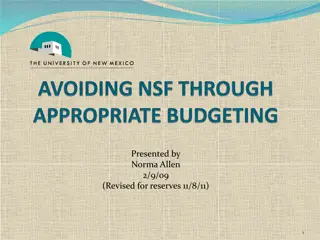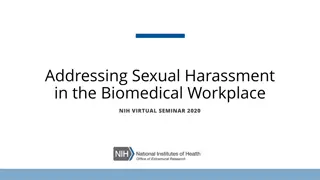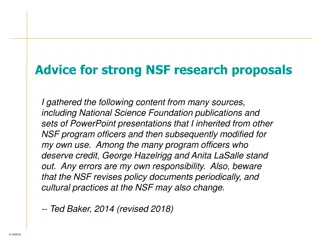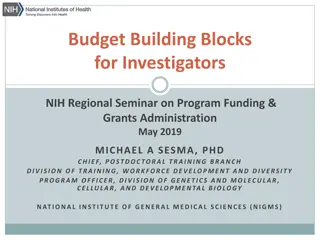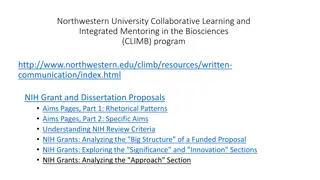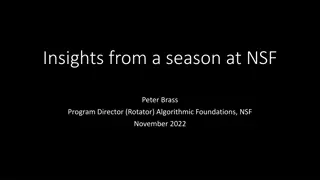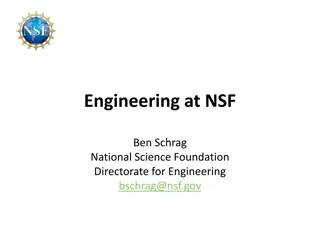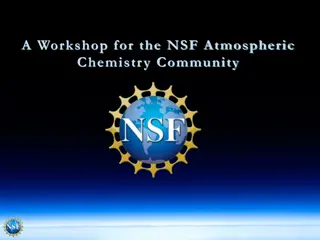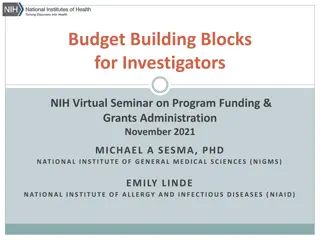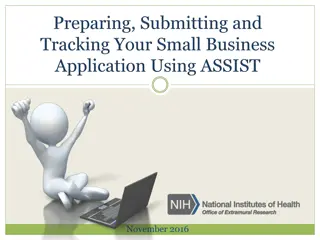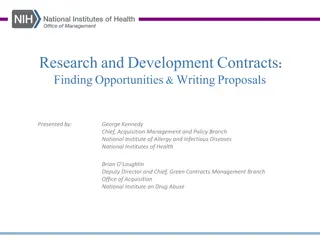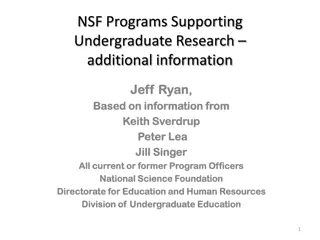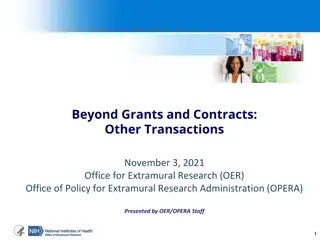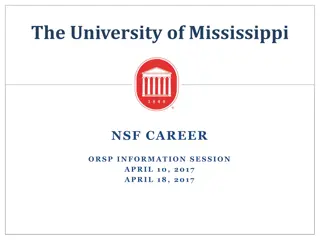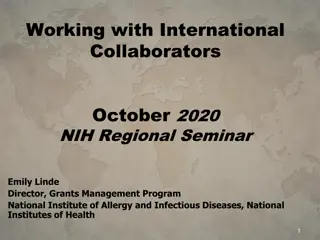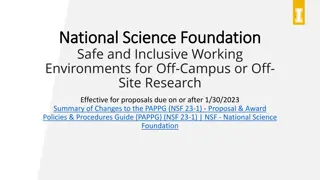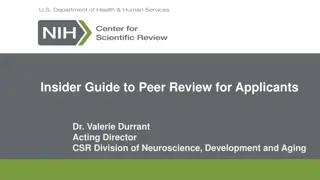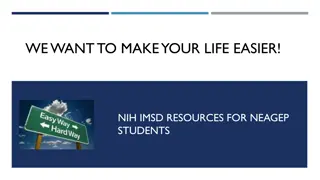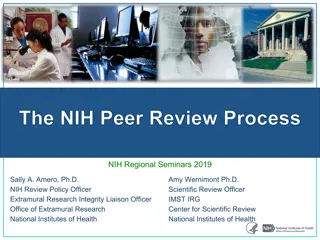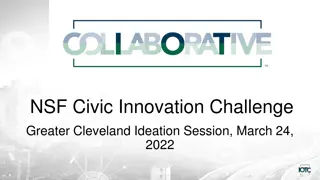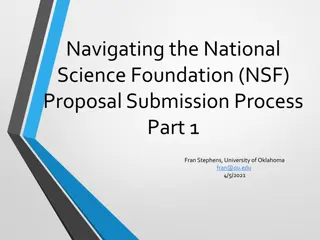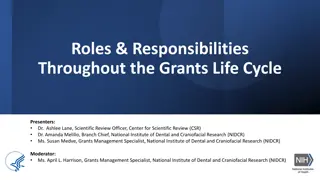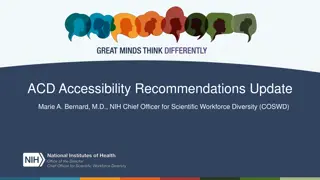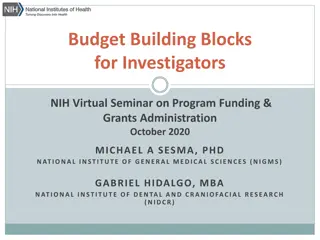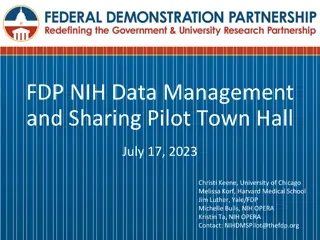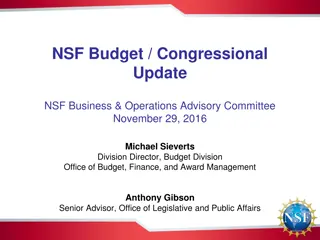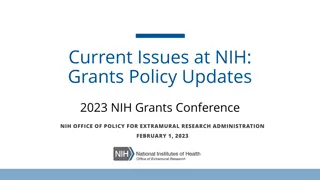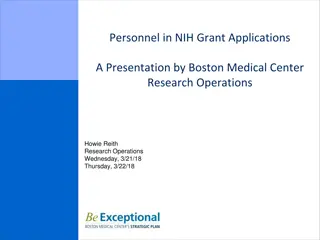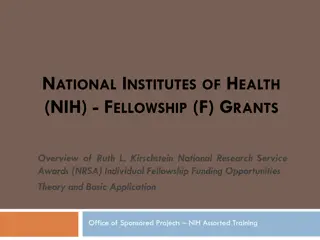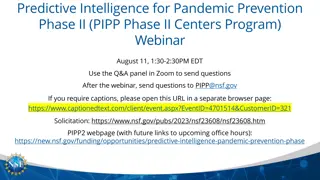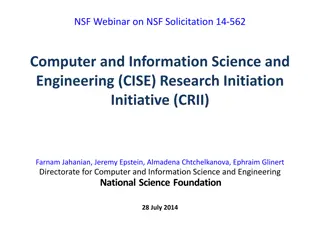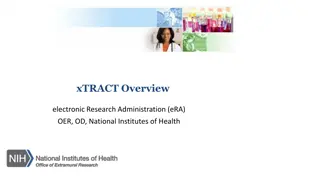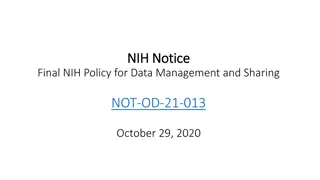Mastering NSF and NIH Research Proposals
Gain insights into crafting research proposals for NSF and NIH, covering proposal evaluation, required documents, and programmatic structures of these major funding agencies. Understand the criteria, review process, and key components of NSF proposals.
Download Presentation

Please find below an Image/Link to download the presentation.
The content on the website is provided AS IS for your information and personal use only. It may not be sold, licensed, or shared on other websites without obtaining consent from the author. Download presentation by click this link. If you encounter any issues during the download, it is possible that the publisher has removed the file from their server.
E N D
Presentation Transcript
Preparing Research Proposals for NSF and NIH April 20, 2018 Presenter: Deborah Hernandez, Director, Research Development
Workshop Objectives For NSF and NIH: Review Research Focus and Programmatic Structure Explain Proposal Evaluation/Review Criteria & Process Understand Required Proposal Documents
Research Focus & Programmatic Structure National Science Foundation Independent Federal Agency whose mission is to keep the U.S. at the leading edge of discovery by supporting research and education in all fields of fundamental science and engineering, except for the medical sciences. https://www.nsf.gov/about/glance.jsp Organized into 7 disciplinary Directorates, each with multiple Divisions/Offices and Programs https://www.nsf.gov/staff/orglist.jsp National Institutes of Health NIH s mission is to seek fundamental knowledge about the nature and behavior of living systems and the application of that knowledge to enhance health, lengthen life, and reduce illness and disability. https://www.nih.gov/about-nih/what-we- do/mission-goals Part of DHHS. Organized into 27 quasi-independent Institutes and Centers with disease and/or target population focus each receives a direct appropriation and manages its own budget https://www.nih.gov/about-nih/what-we-do/nih- almanac/nih-organization
NSF Proposal Evaluation Criteria & Process National Science Foundation Two Standard Merit Review Criteria Intellectual Merit: The potential to advance knowledge and understanding within one s own field or across different fields. Must convey merit of the potential contribution as well as merit of the proposed approach. Broader Impacts: The potential to benefit society and contribute to the achievement of specific, desired societal outcomes. Impacts may be economic, environmental, or educational; may improve research and education infrastructure; or may provide opportunities for underrepresented groups. Review Process ad hoc panel of scientists in program field who provide individual reviews Reviews given to the Program Officer who determines what to fund
NSF Proposals Primary Documents 1-Page Summary with 3 sections Overview Intellectual Merit Broader Impacts 15 page Research Plan References Biosketch (2 pages in specified format) Current and Pending Support document Collaborators Spreadsheet Data Management Plan Budget and Narrative Budget Justification Post Doctoral Mentoring Plan, if applicable Letters of Commitment from Unfunded Collaborators https://www.nsf.gov/pubs/policydocs/pappg18_1/index.jsp
NSF Proposals 1-page summary Overview A stand-alone summary of the planned work. It should: Summarize the scientific or technological challenge you seek to address Present your project goal and specific objectives Identify key components of your proposed approach/methods Intellectual Merit This is your potential to advance knowledge and understanding in an impactful way. Address the merit or significance of the topic, and the merit of your proposed approach/methods. Consider: What will my research add to what we already know? How will my research enhance or enable new directions in my field or in other related fields What is new or novel about my approach and why is it likely to work? Broader Impacts Summarize plans to extend the impact of your research in ways that will benefit larger societal goals related to such things as broadening participation in the sciences, enhancing public health or safety, advancing economic competitiveness, etc.
NSF Proposals Project Description 15 pages with no specified format beyond 3 required sections: intellectual merit, broader impacts, and results from prior NSF support Suggested Format: Introduction page that defines your topic by identifying the main scientific challenges you will address, specifically states your goals and objectives (or hypothesis and research questions), and highlights new ideas/novel approach and the expected impact of your work on the current state of science. Background/Significance 1-3 pages that provides a synopsis of recent findings in the area and summarizes what we do and don t know. If appropriate, identify existing barriers to advances in your area that you will address through this project. This is your literature heavy section and should provide reviewers with a clear understanding of why your proposed work and approach will result in an important contribution to science.
NSF Proposals Project Description Research Plan (8+ pages) is your forward-looking, technical description of planned activities and timeline. Identify WHAT will you do, HOW will you do it, and WHEN you will do it. You may choose to set this up with objectives and tasks, clearly identifying tasks that are sequential versus concurrent and identifying key decision points based on expected task outcomes. Explain WHY your proposed strategy/method is appropriate. This section should logically flow from your background/significance section. Use appropriate graphics. Consider providing a summary timetable to provide a graphic snapshot of the entire project. Results from Prior NSF Support, Broader Impacts, and Intellectual Merit
Proposal Evaluation Criteria & Process National Institutes of Health - Five Criteria, plus Overall Impact Significance Are you addressing an important problem or a critical barrier to progress in the field? How will the result improve knowledge, technical capability, or clinical practice and/or change the concepts, methods, technologies, treatments, services, or preventative interventions that drive the field? Investigator(s) Does the research team have appropriate experience and training and demonstrated record of accomplishments that have advanced their field(s)? Innovation - How will the work shift current research via novel theoretical concepts, approaches or methodologies, instrumentation, or interventions or through refinement, improvement, or new application of existing knowledge? Approach Are strategy, methodology, and analyses well-reasoned and appropriate to accomplish the specific aims of the project? Are potential problems, alternative strategies, and benchmarks presented? If applicable, are plans in place for the protection of human subjects and justification of study design (method and criteria)? Environment Are necessary resources, support, and collaboration in place? Overall Impact: Likelihood the project will exert a sustained, powerful influence on the research field(s) involved
Proposal Evaluation Criteria & Process National Institutes of Health Review Process layered peer and staff review Center for Scientific Review assigns proposals to the IC, Integrated Review Group, (25), and Study Section (173) for review https://public.csr.nih.gov/pages/default.aspx Study Section evaluates for scientific merit; Score 1-9 for each criterion and overall impact https://grants.nih.gov/grants/policy/review/rev_prep/scoring.htm Final impact score is based on each individual reviewer s assessment of the scored criteria plus additional criteria regarding the protection and inclusion of human subjects; vertebrate animal care and welfare; biohazards, and criteria specific to the funding opportunity Overall impact/priority score is calculated by averaging reviewer impact scores. This score is converted to percentile ranking, which determines funding consideration IC program officers then evaluate proposals for program relevance and recommends projects to National Advisory Council for consideration National Advisory Council in each IC provides second level of review and makes funding recommendations to the IC Director
NIH Proposals Primary Documents Project Summary Project Narrative Introduction for resubmissions/revisions Specific Aims Research Strategy (6-12 pages) Significance Innovation Approach References Budget and Budget Narrative Biosketch (5 pages) Facilities and Resources Equipment If applicable - Human Subjects, Animal Subjects, Letters of Support/Consortium Letters, Resource Sharing Plan, & Appendix
NIH Proposals Document Content Project Summary/Abstract - 30 line maximum self contained description of the project which includes a statement of objectives and methods to be employed. Project Narrative (Public Relevance Statement) - 2 3 sentences for lay audience explaining Relevance to Public Health . Specific Aims 1 page This is your scientific summary. Include broad, long-term goals; the hypothesis or hypotheses to be tested; and specific time-phased research objectives (aims). Your goal should be to test a stated hypothesis, create a novel design, solve a specific problem, challenge an existing paradigm or clinical practice, address a critical barrier to progress in the field, or develop a product or new technology. Your specific aims should delineate what you will accomplish by the end of the grant critical steps/deliverables. Briefly address all five review criteria: Significance, Investigators, Innovation, Approach, and Environment
NIH Proposals Document Content The Research Strategy is framed around 3 of the review criteria and is typically 6-12 pages Significance: Are you addressing an important problem? How will scientific knowledge, technical capability, or clinical practice be improved? How will concepts, methods, technologies, treatments, services, or preventative interventions that drive this field be changed? Innovation: To what degree are you using novel theoretical concepts, approaches or methodologies, instrumentation, or interventions or proposing a refinement, improvement, or new application to something already established? Approach: What strategies, methodologies, and analyses will you employ, and are these well-reasoned and appropriate to accomplish the specific aims of the project? Do you address potential problems, alternative strategies, and benchmarks for success? *Must present preliminary results/findings, even if unpublished.


